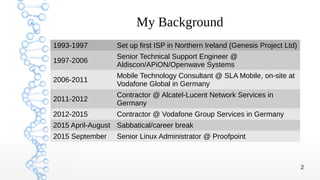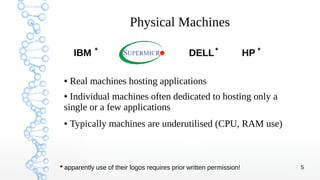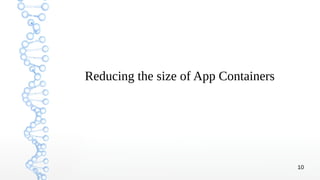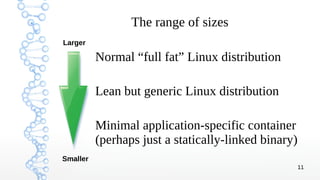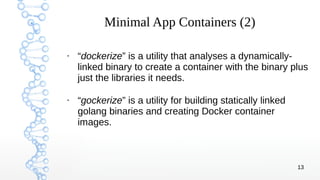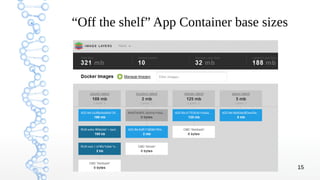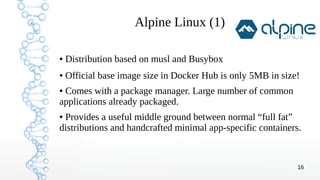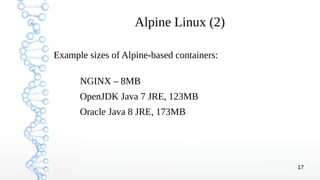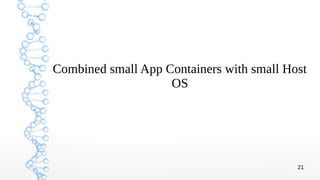Microcontainers, Microservices, Microservers? Less [Linux] is more!
- 1. 1 Microcontainers, Microservices, Microservers. Less [Linux] is more! Belfast Devops 15/09/2015 Dermot Bradley [email protected] http://uk.linkedin.com/in/bradleydermot
- 2. 2 My Background 1993-1997 Set up first ISP in Northern Ireland (Genesis Project Ltd) 1997-2006 Senior Technical Support Engineer @ Aldiscon/APiON/Openwave Systems 2006-2011 Mobile Technology Consultant @ SLA Mobile, on-site at Vodafone Global in Germany 2011-2012 Contractor @ Alcatel-Lucent Network Services in Germany 2012-2015 Contractor @ Vodafone Group Services in Germany 2015 April-August Sabbatical/career break 2015 September Senior Linux Administrator @ Proofpoint
- 3. 3 Talk Overview In a Microservices vision large scale services can be built by combining Application Containers like Lego bricks. However App Containers are not usually lightweight – a typical Docker container uses Ubuntu as its base. Alternatively if based on minimal Linux distributions or (in a more extreme case) applications are just statically linked, the resulting containers can be far smaller. Lightweight means faster startup & migration time between hosts and less RAM use. And as for the container hosts? Whether VM instances or bare metal, the underlying OS can also be stripped right down – CoreOS and RancherOS were designed with exactly this in mind. Together lightweight containers and hosts mean savings – fewer, smaller, cheaper cloud VM instances or bare metal servers (such as Microservers) and potentially improved security.
- 4. 4 The progression from physical machines to application containers
- 5. 5 Physical Machines ● Real machines hosting applications ● Individual machines often dedicated to hosting only a single or a few applications ● Typically machines are underutilised (CPU, RAM use) IBM HPDELL* * * * apparently use of their logos requires prior written permission!
- 6. 6 Virtual Machines ● Provides a degree of application isolation allowing several physical machines to be replaced by 1 physical machine hosting multiple VMs ● Results in better physical machine utilisation
- 7. 7 OS Containers ● Single kernel shared between containers – better I/O (disk, network) performance than VMs but “weaker” security isolation between containers ● Faster startup time than VMs
- 8. 8 Application Containers ● An application plus “just enough” OS to support the app (i.e. no sshd, no syslogd, no init, etc) ● Immutable Infrastructure – no need to use Puppet/Chef/Ansible/Salt to manage them ● The same container is portable across physical hosts, VMs, and multiple cloud providers ● The exact same container can be run on a developer's laptop, in a testlab, and in production environment
- 9. 9 Various architectures of container use Physical Machine Physical Machine Host OS Host OSHost OS Hypervisor Cont ainer Cont ainer Cont ainer Cont ainer Cont ainer Cont ainer Cont ainer Cont ainer Cloud Provider Responsibility Cloud Provider Responsibility Bare Metal Virtualisation Cloud for VMs Cloud for Containers
- 10. 10 Reducing the size of App Containers
- 11. 11 The range of sizes Normal “full fat” Linux distribution Lean but generic Linux distribution Minimal application-specific container (perhaps just a statically-linked binary) Larger Smaller
- 12. 12 Minimal App Containers (1) An application-specific container where the application is compiled & either statically linked (resulting in just a single binary file in the container) or dynamically linked (resulting in a binary plus dependant libraries).
- 13. 13 Minimal App Containers (2) ● “dockerize” is a utility that analyses a dynamically- linked binary to create a container with the binary plus just the libraries it needs. ● “gockerize” is a utility for building statically linked golang binaries and creating Docker container images.
- 14. 14 Minimal App Containers (3) Examples of “extreme” minimal containers: ● Nginx (with Openssl) – 3.034MB ● Python (StaticPython) – 8.5MB ● PostgreSQL – 15.82MB http://mwcampbell.us/blog/tiny-docker-musl-images.html https://github.com/elyase/docker/tree/master/staticpython http://yasermartinez.com/blog/posts/creating-super-small-docker-images.html
- 15. 15 “Off the shelf” App Container base sizes
- 16. 16 Alpine Linux (1) ● Distribution based on musl and Busybox ● Official base image size in Docker Hub is only 5MB in size! ● Comes with a package manager. Large number of common applications already packaged. ● Provides a useful middle ground between normal “full fat” distributions and handcrafted minimal app-specific containers.
- 17. 17 Alpine Linux (2) NGINX – 8MB OpenJDK Java 7 JRE, 123MB Oracle Java 8 JRE, 173MB Example sizes of Alpine-based containers:
- 18. 18 Reducing the size of the Host OS
- 19. 19 Host OS Options (1) ● RancherOS, 20MB ● Boot2Docker, 24MB ● CoreOS, 190MB ● Vmware Photon OS, 207MB ● Intel ClearLinux, 800MB ● Project Atomic, 800MB ● Snappy Core Linux, 3.9GB?? Container-oriented distributions:
- 20. 20 Host OS Options (2) ● TinyCore Linux, 10MB+ ● Alpine Linux, 87MB+ Generic distributions: Size is of base distribution, does not take into account size of Docker tools etc...
- 21. 21 Combined small App Containers with small Host OS
- 22. 22 Benefits of combined reductions ● Smaller spec Cloud VMs or physical servers can be utilised ● Cost savings! ● Quicker app container and/or host VM migration ● Smaller attack surface
- 23. 23 Special case: App Container & slim VM merged
- 24. 24 Intel Clear Containers ● KVM hypervisor ● Uses kvmtool (no need for BIOS/UEFI) ● Stripped-down Linux kernel (only Virtio devices) ● Systemd as init ● Rkt containers supported (docker support soon) ● Startup almost as fast (150ms) as native container ● Per-container RAM overhead of 18-20MB ● Container running inside a lightweight VM
- 25. 25 Microservices
- 26. 26 Microservices (1) “Microservices is a software architecture style in which complex applications are composed of small, independent processes communicating with each other using language- agnostic APIs. These services are small, highly decoupled and focus on doing a small task, facilitating a modular approach to system-building” Wikipedia definition: http://en.wikipedia.org/wiki/Microservices
- 27. 27 Microservices (2) ● “small independent processes” ● “highly decoupled” ● “modular approach to system building” App Containers fit the Microservices model perfectly:
- 28. 28 Microservices (3) Database Database Application Content Server Load Balancer Content Server Application Application Lego brick approach to building services
- 29. 29 Microservices (4) ● Load Balancer: HAproxy ● Content Server: Apache, Nginx ● Application run-times: Perl, PHP, Python, Ruby, Node.js, JVM ● Database: MariaDB, PostgreSQL, MongoDB ● Caching: Memcached, Varnish Typical App Container building blocks:
- 30. 30 Microservices (5) Perhaps there is a demand for a curated set of such minimal App Container building blocks? Am I volunteering? Who knows...
- 31. 31 Microservers
- 32. 32 Microservers (1) Dell CS5220 12 unit chassis
- 33. 33 Microserver (2) Facebook/OCP Mono Lake <90W microserver for Yosemite sled
- 35. 35 Microservers (4) ● Low cost, low power usage, small size physical server ● Not every task needs high-end CPUs and lots of RAM
- 37. 37 Micro Data Centre (1)
- 38. 38 Micro Data Centre (2) ● Small rack cabinet with multiple compute nodes, storage nodes, admin node(s), network switch, UPS, etc ● 10U cabinet capable of hosting 4000+ containers?
- 39. 39 Micro Data Centre (3) ● No special (physical, power, cooling) room requirements unlike a normal data centre ● Easier to keep data on-site for legal or privacy reasons ● Potentially economical to have multi-site redundancy with 2 MDCs in separate but geographically-close (low network latency) locations
- 40. 40 Personal experimentation – my current Micro Data Centre
- 41. 41 Testlab summary ● Multiple Compute Nodes ● 3+ Storage Nodes ● Admin Node ● Managed Switch
- 42. 42 Compute Nodes (1) ● Off-the-shelf Mini-ITX motherboards with low power CPUs (with passive heatsinks or heatsink/fans) ● Small amounts of RAM, 4-8Gb. Low power (1.35V) DDR3L if possible. ● No local storage ● Low wattage small power supply ● Machines PXE boot the Host OS and run directly from RAM
- 44. 44 Compute Nodes (3) ● My intention is to make a custom low-cost blade-type chassis for nodes. ● Chassis will be approx. 6U high and 250mm deep with 12 compute nodes per chassis. ● Individual nodes will be approx. 6Ux 35mm x 245mm
- 45. 45 Storage Nodes ● Low power CPUs on Mini-ITX motherboards ● Mix of SSDs and HDDs ● Using CEPH to provide storage services
- 46. 46 Admin Node Pair of HDDs used with software mirroring ● Provides DHCP/TFTP/HTTP services for PXE booting Compute Nodes ● Will run InfluxDB, ElasticSearch and Kibana for metric and log analysis
- 47. 47 Network Infrastructure ● Gigabit Ethernet managed switch with VLAN, IPv6, and SSH support ● Use Ansible, via SSH, to configure the switch ● Plan is for all containers & hosts to use only IPv6 addressing. The entry point to the “cloud” (i.e. Load Balancer) will handle both IPv4 and IPv6 external addresses and forward traffic onwards to internal IPv6 addresses.
![1
Microcontainers, Microservices, Microservers.
Less [Linux] is more!
Belfast Devops
15/09/2015
Dermot Bradley
dermot_bradley@yahoo.com
http://uk.linkedin.com/in/bradleydermot](https://image.slidesharecdn.com/belfast-devops-presentation-150916011027-lva1-app6891/85/Microcontainers-Microservices-Microservers-Less-Linux-is-more-1-320.jpg)
